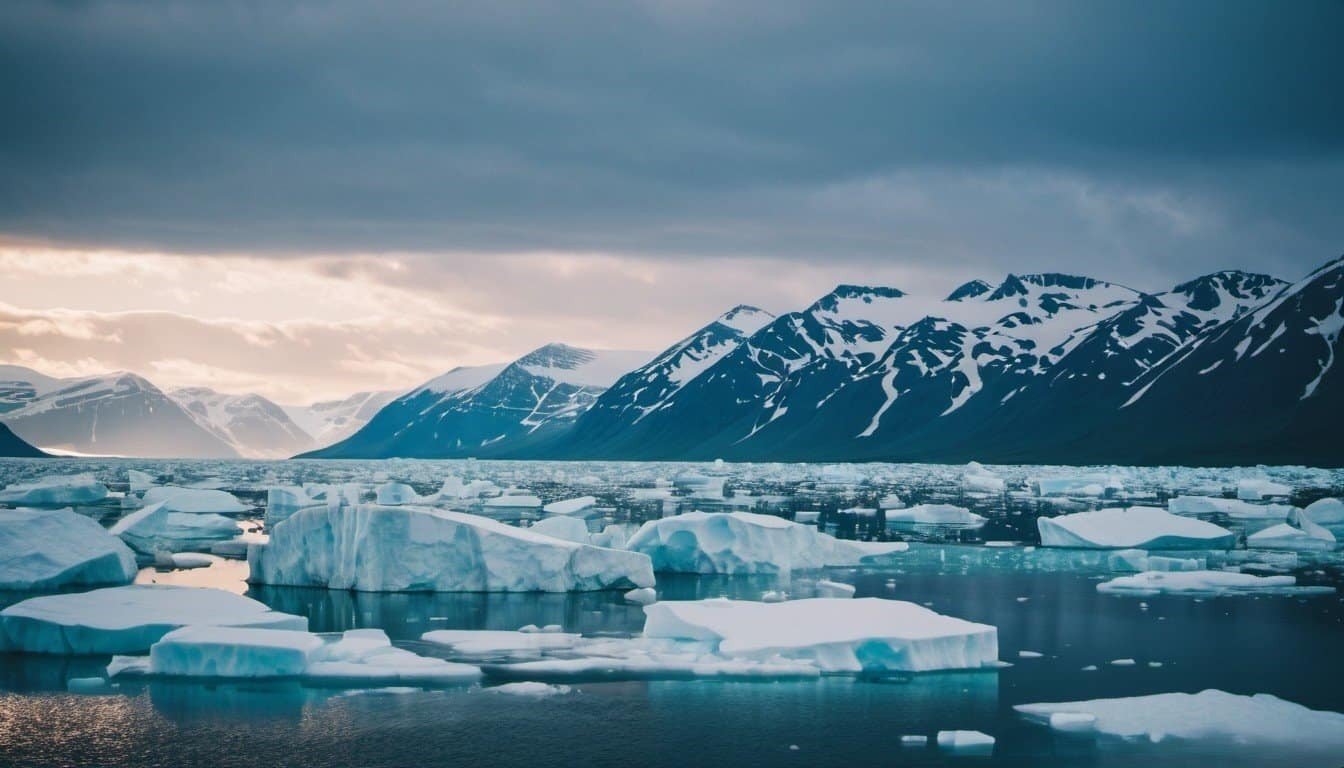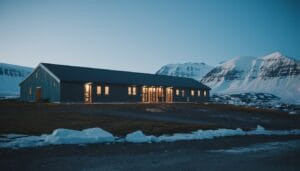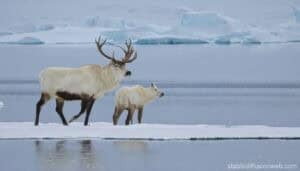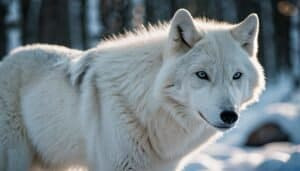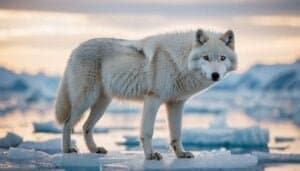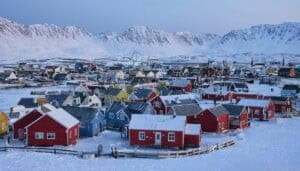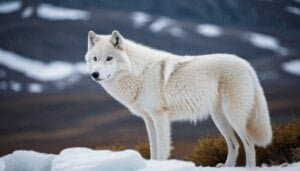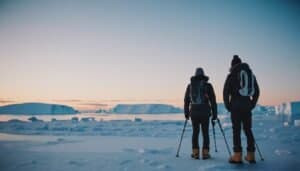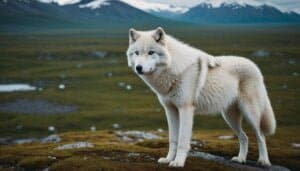Introduction
Arctic wolves, majestic inhabitants of one of the harshest environments on Earth, are facing unprecedented challenges due to climate change. As the Arctic continues to warm, these wolves are experiencing significant changes in their habitat, prey availability, and overall ecosystem
This article delves into the impact of climate change on Arctic wolves, examining their adaptation strategies, long-term survival prospects, and the ongoing conservation efforts
Additionally, it explores the crucial role these wolves play in the Arctic ecosystem and highlights the scientific research aimed at understanding and mitigating these impacts
The Impact of Climate Change on Arctic Wolves
The Arctic is undergoing rapid changes due to climate change, and these transformations are significantly affecting its native wildlife, including the Arctic wolf
This section explores the major impacts of climate change on Arctic wolves, focusing on habitat loss, changes in prey availability, and the wolves’ adaptation strategies
Habitat Loss Due to Melting Ice
The Arctic is warming at approximately twice the rate of the global average, leading to significant ice melt. This loss of ice and permafrost is drastically altering the landscape that Arctic wolves call home. Arctic wolves are highly adapted to cold, icy environments, relying on sea ice and tundra to hunt and travel
As the ice melts, these habitats shrink, limiting the wolves’ range and forcing them into smaller, fragmented areas
The reduction in sea ice also impacts the wolves’ ability to traverse their territory. Historically, Arctic wolves have used ice bridges to move between islands and the mainland, accessing different hunting grounds
With these bridges disappearing, their movement becomes restricted, leading to increased competition for dwindling resources and higher mortality rates
Additionally, the melting permafrost leads to the loss of den sites. Arctic wolves use dens for shelter and raising their pups. As the ground thaws, these dens collapse or become unsuitable, making it harder for wolves to find safe places to rear their young
This can lead to lower reproductive success and declining wolf populations
Changes in Prey Availability
Climate change also affects the availability of prey species, which are crucial for the survival of Arctic wolves. Caribou, musk oxen, and Arctic hares make up the bulk of the wolves’ diet. However, the populations and behaviors of these prey animals are shifting due to the changing climate
Warmer temperatures and changing vegetation patterns influence caribou migration routes and timing. Caribou are moving to different areas and altering their migratory patterns in response to new plant growth and food sources
This makes it more difficult for Arctic wolves to predict and follow caribou herds, reducing their hunting success
Similarly, musk oxen are affected by the warming climate. Changes in snow cover and vegetation impact their distribution and availability as prey for wolves. As these animals struggle to adapt to the new conditions, their populations may decline, leaving wolves with fewer hunting opportunities
Arctic hares, another important food source, are also experiencing habitat shifts. As the tundra warms, hares may move to cooler, higher elevations, reducing their accessibility to wolves
This decline in prey availability forces Arctic wolves to travel longer distances and expend more energy to find food, ultimately affecting their health and survival
Adaptation Strategies of Arctic Wolves
Despite these challenges, Arctic wolves are known for their remarkable adaptability. They employ various strategies to cope with the changing environment. One key adaptation is their flexible diet. While they prefer large ungulates like caribou and musk oxen, Arctic wolves can also hunt smaller mammals and scavenge when necessary
This dietary flexibility allows them to survive when their preferred prey is scarce
Arctic wolves are also adjusting their hunting behaviors. They may form larger or smaller packs depending on the availability of prey. Larger packs can take down bigger prey, but when food is scarce, smaller packs or lone wolves may have better success hunting smaller animals. This social flexibility helps them optimize their hunting efficiency in a changing landscape
Additionally, Arctic wolves exhibit changes in their reproductive strategies. In response to environmental stressors, they may alter their breeding timing and litter size. These adjustments help ensure that their offspring have a higher chance of survival despite the unpredictable conditions
Moreover, Arctic wolves are known to travel long distances in search of food and suitable habitat. Their large territories and nomadic nature enable them to exploit a variety of environments and resources, enhancing their chances of survival in a dynamic Arctic ecosystem
Long-Term Survival Prospects and Conservation Efforts
The long-term survival of Arctic wolves in the face of climate change is a topic of growing concern among scientists and conservationists
This section explores the predictions for Arctic wolves’ future, their behavioral changes in response to the changing climate, and the conservation efforts and challenges involved in protecting these resilient predators
Predictions for Arctic Wolves’ Future
The future of Arctic wolves is uncertain as climate change accelerates. Predictions suggest that the continued warming of the Arctic will further reduce the availability of sea ice and tundra, essential components of the wolves’ habitat
This habitat loss could lead to smaller and more fragmented populations, making it harder for wolves to find mates and maintain genetic diversity
Additionally, the shifting patterns of prey species will likely continue to challenge Arctic wolves. If prey populations decline or move out of reach, wolves may face increased competition and struggle to find sufficient food. This could result in lower reproductive rates and higher mortality, threatening the long-term viability of wolf populations
However, some researchers believe that Arctic wolves’ adaptability and resilience may enable them to cope with these changes to some extent. Wolves that can exploit a wider range of food sources and adjust their behaviors may have a better chance of surviving in the altered environment
Nevertheless, the overall outlook remains cautious, with many unknowns about how rapidly the ecosystem will change and how well wolves can adapt
Behavioral Changes in Response to Climate Change
Arctic wolves are already exhibiting notable behavioral changes in response to the warming climate. One of the most significant changes is in their hunting strategies. As traditional prey like caribou and musk oxen become harder to find, wolves are increasingly turning to alternative food sources
This includes hunting smaller mammals, scavenging more frequently, and even occasionally preying on birds and fish
These shifts in diet are accompanied by changes in pack dynamics. Smaller packs or even lone wolves may become more common as wolves adapt to the reduced availability of large prey. These changes can affect the social structure and cooperation within packs, which are crucial for hunting and raising young
Furthermore, Arctic wolves are modifying their movement patterns. With the loss of ice bridges and changing prey distributions, wolves are traveling greater distances to find food and suitable habitat
This increased mobility requires more energy and poses additional risks, but it also demonstrates the wolves’ remarkable ability to adapt to their environment
Conservation Efforts and Challenges
Conservation efforts to protect Arctic wolves are becoming increasingly important as their habitat and prey continue to be threatened by climate change. These efforts involve a combination of research, habitat protection, and policy initiatives aimed at mitigating the impacts of climate change
One key approach is the establishment of protected areas that preserve critical habitats for Arctic wolves and their prey. By safeguarding these regions from industrial development and other human activities, conservationists hope to provide refuges where wolves can thrive despite the changing climate
Another important aspect of conservation is ongoing research and monitoring. Scientists are tracking wolf populations, studying their behavior, and assessing the health of their ecosystems. This data is crucial for understanding the effects of climate change and developing effective conservation strategies
However, there are significant challenges to these efforts. The vast and remote nature of the Arctic makes it difficult to conduct comprehensive research and enforce protective measures
Additionally, the global scale of climate change means that local conservation efforts must be supported by broader initiatives to reduce greenhouse gas emissions and slow the warming trend
International cooperation is also essential, as Arctic wolves’ ranges often span multiple countries. Collaborative efforts between nations can enhance conservation outcomes by sharing knowledge, resources, and strategies
Ecological Role and Research of Arctic Wolves
Arctic wolves play a vital role in their ecosystem, acting as top predators that help maintain the balance of species within their habitat
This section examines their ecological importance, changes in ecosystem dynamics due to climate change, and the research and monitoring efforts aimed at understanding and supporting Arctic wolf populations
Ecological Importance of Arctic Wolves
Arctic wolves are apex predators in their ecosystem, meaning they have no natural enemies except humans. As such, they play a crucial role in regulating the populations of their prey species, such as caribou, musk oxen, and Arctic hares. By controlling the numbers of these herbivores, wolves help to maintain the health and balance of the tundra and Arctic ecosystems
The presence of Arctic wolves influences the behavior and distribution of their prey. For example, caribou herds tend to avoid areas with high wolf activity, which can prevent overgrazing in certain regions
This indirect effect helps to preserve the vegetation and overall biodiversity of the area. Additionally, wolves contribute to the nutrient cycle by leaving behind carcasses that provide food for scavengers and enrich the soil
Furthermore, the predation pressure exerted by wolves can lead to healthier prey populations. By typically preying on the sick, weak, or old individuals, wolves help to ensure that only the fittest animals survive and reproduce. This natural selection process can enhance the genetic health of prey species over time
Changes in Ecosystem Dynamics
Climate change is altering the dynamics of Arctic ecosystems, and these changes are affecting the ecological role of Arctic wolves. As the climate warms, the distribution and behavior of both prey and predators are shifting, leading to new interactions and challenges
One significant change is the northward migration of some species. As southern species move into the Arctic in response to warming temperatures, they introduce new competition and predation pressures
For example, red foxes, which are typically found in more temperate regions, are moving north and competing with Arctic foxes and wolves for food and territory. This new dynamic can disrupt existing predator-prey relationships and add stress to already struggling Arctic wolf populations
Additionally, the changing vegetation patterns due to climate change impact the availability of food for herbivores, which in turn affects wolves. As plant communities shift, so do the habitats and feeding grounds of prey species like caribou and musk oxen. This can lead to mismatches between the timing of prey availability and the wolves’ hunting needs, further complicating their survival
The loss of sea ice also affects marine food webs, which can indirectly impact Arctic wolves. For instance, polar bears, which rely on sea ice for hunting seals, may venture further inland in search of food, potentially competing with wolves for terrestrial prey. Such changes in predator interactions can have cascading effects throughout the ecosystem
Research and Monitoring Efforts
Understanding the complex impacts of climate change on Arctic wolves requires comprehensive research and monitoring. Scientists are employing various methods to study these elusive predators and their environment, including satellite tracking, field observations, and genetic analysis
Satellite tracking allows researchers to monitor the movements and behavior of Arctic wolves over vast distances. By attaching GPS collars to wolves, scientists can gather data on their travel patterns, hunting areas, and interactions with other animals
This information is crucial for understanding how wolves are adapting to the changing landscape and identifying critical habitats that need protection
Field observations provide valuable insights into the daily lives of Arctic wolves. Researchers spend time in the field observing wolf packs, recording their behaviors, and collecting data on prey populations. This hands-on approach helps to build a detailed picture of the wolves’ ecological roles and the challenges they face
Genetic analysis is another important tool in wolf research. By studying the DNA of Arctic wolves, scientists can assess their genetic diversity, population structure, and health. This information is essential for developing effective conservation strategies, as it helps to identify inbreeding risks and the potential for population decline
Long-term monitoring is also vital for tracking changes over time. By comparing data collected over decades, researchers can identify trends and make predictions about future impacts. This longitudinal approach provides a deeper understanding of how climate change is affecting Arctic wolves and their ecosystem, informing adaptive management practices
Conclusion
Arctic wolves, resilient and adaptable apex predators, face numerous challenges as climate change rapidly transforms their environment
This article has explored the impact of climate change on Arctic wolves, detailing the loss of habitat, changes in prey availability, and their impressive adaptation strategies. It has also examined their long-term survival prospects and the conservation efforts being undertaken to protect them
The ecological importance of Arctic wolves cannot be overstated; they play a crucial role in maintaining the balance of the Arctic ecosystem. However, the shifting dynamics brought about by climate change, such as the migration of new species into the Arctic and the altering behaviors of prey, are creating complex challenges for these wolves
To ensure the survival of Arctic wolves, comprehensive research and monitoring efforts are essential. By tracking their movements, studying their behaviors, and analyzing their genetic health, scientists can develop informed conservation strategies. These efforts must be supported by broader initiatives to mitigate climate change and protect critical habitats
In summary, the future of Arctic wolves hinges on our ability to address climate change and implement effective conservation measures. Protecting these majestic creatures and their environment is not only vital for their survival but also for the health and balance of the entire Arctic ecosystem
